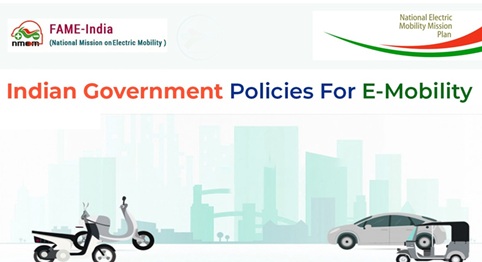| (Mains, General Studies Paper- 2: Issues arising out of Government policies and interventions for development in various sectors and their design and implementation) |

Context
On July 11, 2025, the Central Government announced a special allocation of ₹500 crore to incentivise the purchase of electric trucks under the Pradhan Mantri e-Drive initiative.
Recent Announcement
- The recent announcement is part of a broader outlay of ₹10,900 crore that includes assistance for e-two-wheelers, e-three-wheelers, e-ambulances and e-buses.
- The incentive is for 5,643 electric trucks to be procured in FY 2026.
Eligibility
- The eligibility for this announcement applies to trucks weighing 3.5 tonnes to 55 tonnes (N2 & N3 categories) including puller tractors in articulated vehicles.
- Buyers will have to submit a scrappage certificate or a certificate of deposit for a diesel/ICE truck of equal or greater gross vehicle weight (GVW) to qualify.
- Providing minimum warranty to vehicles: Battery- 5 years or 5 lakh km and Motor & Vehicle- 5 years or 2.5 lakh km, whichever is earlier.
- Out of the ₹500 crore, ₹100 crore will be specifically for incentivising 1,100 e-trucks registered in Delhi, aimed at tackling air pollution in the capital.
Significance
- Diesel trucks constitute only 3% of vehicles but contribute significantly to air pollution by contributing 42% of transport-related greenhouse gas emissions.
- The scrappage requirement links clean transport with the phasing out of older, more polluting vehicles.
- Reliability conditions enforced through minimum warranty limits aim to ensure long-term performance standards.
- Significant reduction in costs makes electric trucks more viable in high-capital industries.
Potential challenges
- High upfront cost of e-trucks despite incentives
- Scrappage certificate requirement as a barrier for first-time buyers or small operators
- Limitations of charging infrastructure, especially for long-distance operations
Government initiatives for e-mobility
FAME scheme (Faster Adoption and Manufacturing of Hybrid and Electric Vehicles)
- FAME-I (2015-2019): Focus on demand stimulation and R&D support for e-vehicles
- FAME-II (2019-2024): Outlay of ₹10,000 crore for e-2W, e-3W, e-buses and charging infrastructure
- Target: 7,000 e-buses, 5 lakh e-3W, 55,000 e-4W and 10 lakh e-2W
Pradhan Mantri e-Drive Yojana (2024-2026)
- New initiatives after FAME-II
- Outlay of ₹10,900 crore
- Focus on promoting e-2W, e-3W, e-buses and e-trucks
- ₹500 crore exclusively for electric trucks, with scrappage-linked incentives
Production Linked Incentive (PLI) Scheme
- ₹18,100 crore for advanced chemistry cell (ACC) battery manufacturing
- ₹26,000 crore PLI for automobile and auto component sector
- Aims to promote domestic EV and battery production
Charging infrastructure development
- FAME-II: Financial assistance for setting up 2,877 public EV charging stations in 68 cities and 25 highways
- Bharat EV Charger Specifications (AC-001, DC-001) for standardization released.
Battery Swapping Policy (Draft 2022)
- Focuses on interoperability standards, particularly for e-2W & e-3W
- Targets commercial fleet operators, ride-hailing and delivery services.
Energy Storage & Recycling
- Battery recycling framework under development
- Focus on circular economy for battery materials
State-Level Initiatives
- More than 20 states have notified dedicated EV policies including:
- Delhi EV Policy: Strong incentives, scrappage benefits
- Maharashtra EV Policy: Targets 10% of all new vehicles to be electric by 2025
- Tamil Nadu EV Policy 2023: Focus on EV manufacturing & exports
Public Sector & Institutional Incentives
- SAIL, NTPC and other PSUs are deploying e-trucks and EV fleets.
- EESL (Energy Efficiency Services Limited): Procurement and deployment of e-cars in government offices.
- Indian Railways: Working on full electrification and shifting internal logistics to e-mobility.
Global Commitments and Vision
- India’s Nationally Determined Contribution (NDC): To reduce the emission intensity of GDP by 45% by 2030.
- Target: 30% of all vehicles will be electric by 2030.
- Part of the EV30@30 campaign under the Clean Energy Ministerial Meeting.
